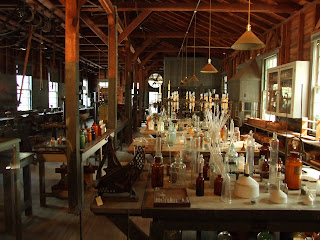Pictured above, Thomas Edison's laboratory and the Eames' office space, are two different spaces that served and inspired their users in a way that was functional and pleasing to each. Our studio spaces should inspire us to work as a cohesive part of the design process.
Edison's laboratory is a very open space. The space itself is tall and raw and Edison's things are displayed openly within the space, rather than stuffed in cabinets.
There is something whimsical, something magical about the Eames' office. Inspiration and ideas hung on the walls and tucked into the nooks and crannies add character and a childlike essense that creates such a delightful workspace. The space is beaming with motivation and enthusiasm.
Our spaces should stimulate and energize us; provoke thoughts and visions. Inspire.
A wall of inspiration.
An inspiration drawer.
An inspiration journal.
Inspiration. Key.
I have tons of little things that provoke big ideas and I think it's important to not only keep these things but to display them or have them handy so you can later pull from them.
I myself don't like to be stuck inside to do my work. Being outside inspires me, so I love the idea of a little...maybe not this little...backyard studio.
I also like the proximity to home but still being able to keep your work at arms length when you're done for the day.
I could go on and on and show tons of pictures of creative spaces but the common thread is that they bring out your creative side. They are functional and motivating.











